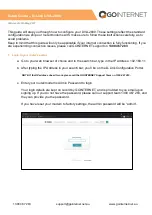
MRX-900 Operating Manual: RS-232 Interface and Cables
19
C. RS-232 Interface and Cables
“Straight-through”
DB9-to-DB9
RS-232 Cable
Modem
(DCE)
9-pin male
Signal
Terminal
(DTE)
9-pin
1
DCD
→
1
2
RX
→
2
3
←
TX
3
4
←
DTR
4
5
SG
→
5
6
DSR
→
6
7
←
RTS
7
8
CTS
→
8
9 (n/c)
(n/c) 9
“Straight-through”
DB9-to-DB25
RS-232 Cable
Modem
(DCE)
9-pin male
Signal
Terminal
(DTE)
25-pin
1
DCD
→
8
2
RX
→
3
3
←
TX
2
4
←
DTR
20
5
SG
→
7
6
DSR
→
6
7
←
RTS
4
8
CTS
→
5
9 (n/c)
Arrows denote the direction that
signals are asserted (
e.g.
, DCD
originates at the DCE and tells the
DTE that a carrier is present).
C.0 RS-232 Line Signals
The MRX-900 uses a 9-pin D-sub connector for asynchronous serial I/O.
The pin assignments conform to standard RS-232 signals, so a common serial
cable can be used for interfacing the MRX-900 to most DTE devices.
Line signals in the RS-232 interface are described below:
DCD
Data Carrier Detect
- When set high, DCD informs the DTE that a
communications link has been established with another MRX-900.
RX
Receive Data
- Signals transferred from the MRX-900 are received by the
DTE via RX.
TX
Transmit Data
- Signals are transmitted from the DTE via TX to the
MRX-900
DTR
Data Terminal Ready
- Raised to an active level by the DTE to inform the
modem that it is alive and ready for communications.
SG
Signal Ground
- Provides a ground reference for all signals transmitted by
both DTE and DCE.
DSR
Data Set Ready
- Set high by the modem (DCE, or “data set” as it was
formerly called) to inform the DTE that it is alive and ready for
communications. DSR is the modem’s equivalent of the DTR signal.
RTS
Request to Send
- A “handshaking” signal which is asserted by the DTE when
it is ready to transmit data. (Typically, the DCE responds by activating CTS.)
Essentially, RTS is the DTE’s way of saying, “I am ready to send data
whenever you are.”
CTS
Clear to Send
- A “handshaking” signal set active by the DCE when it has
enabled communications and transmission from the DTE can commence.
CTS is usually asserted after the DCE has detected a RTS signal from the
DTE. It is the modem’s way of saying, “Go ahead, I am ready for your data.”
Notes:
It is typical to refer to RX and TX from the perspective of the DTE. This should be
kept in mind when looking at signals relative to the modem (DCE); the modem
transmits
data on the RX line, and
receives
on TX.
“DCE” and “modem” are often synonymous since a modem is typically a DCE device.
“DTE” is, in the most common application, is a device such as a computer.
C.1 DTE-to-DCE (Straight-Through) Cables
Due to the variety of cabling requirements by each user of the MRX-900,
interface cables required for DTE-to-DCE connection are user-supplied
items. Unless the RS-232 port or connector on the DTE deviates from the
common pin assignments, it is recommended that pre-fabricated shielded
cables (and interface adapters, if necessary) be purchased for your application
to ensure optimal performance and reliability. In cases where an RJ-45 DTE
termination is required, the cable will need to be designed according to the
DTE’s RJ-45 pinout; this 8-position connector has no standard assignment of
signals and varies greatly between devices and manufacturers.
If cables must be fabricated, the wiring diagrams provided should be used.
For best results, it is recommended that cables be no longer than necessary to
interface the DTE and DCE (up to about 25 feet).
Summary of Contents for MRX-900
Page 4: ...ii MRX 900 Operating Manual...
Page 20: ...16 MRX 900 Operating Manual...
Page 26: ...22 MRX 900 Operating Manual...
Page 30: ...26 MRX 900 Operating Manual...










































